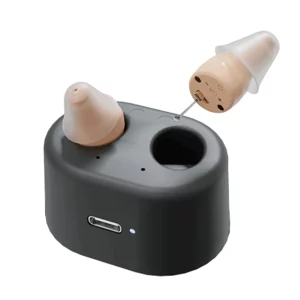Want to hear clearly and enjoy all the different sounds around you again?
Having trouble hearing is tough, but the right hearing aid can help a lot. There are so many choices out there, it can be hard to pick the best one. That’s why we decided to test the most popular hearing aids of 2023 and see how they work.
#1 BEST HEARING AIDS
PROS
✓ #1 Most Popular Choice
✓ Unbeatable Price
✓ Most Comfortable
✓ Small & Invisible
✓ 45-day return policy
✓ Rechargeable (Wireless)
✓ Over 20+ Hours In A Single Charge
✓ Free and Fast Shipping
✓ Great Sound
✓ User-Firendly
CONS
x May run out of stock
REVIEW
Many people have shown an interest in Audien Atom due to its ability to enhance hearing, affordability, and comfortable design.
To begin, the Audien Atom excels in its capacity to improve sound quality, allowing wearers to experience clearer and more vibrant auditory sensations. Moreover, its user-friendly nature makes it accessible to a everyone, regardless of their familiarity with technology.
Notably, one of the key advantages of the Audien Atom is its accessible price point. It stands out as a more affordable option compared to its competitors in the market. This affordability doesn’t compromise the quality or effectiveness of the device, making it an attractive solution for those seeking an impactful yet budget-friendly hearing aid.
When you make a purchase of the Audien Atom, you’ll benefit from prompt and cost-free shipping. What’s more, the Audien Atom comes with a noteworthy 45-day money-back guarantee. This generous time frame provides users with ample opportunity to test the hearing aid and assess its suitability for their needs.
FINAL VEREDICT
In conclusion, the Audien Atom hearing aid distinguishes itself for multiple reasons. With its ability to enhance sound, affordability, and comfortable fit, it stands as a compelling option.
Its user-friendly design, expedient and free shipping, coupled with the substantial money-back guarantee, solidify its status as an appealing choice for individuals in search of an effective, economical, and comfortable hearing aid solution. Read more.
LEXIE
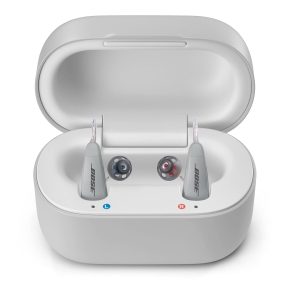
8.6
“Great”
★★★★☆
User Ratings (23,166)
$899
PROS
✓ Sleek Design
✓ Comfortable
✓ Small
✓ User-Friendly
✓ Noise Reduction
✓ Good Volume Control
✓ Rechargeable
✓ Compact and Portable
CONS
x Short Battery Life
x Expensive
REVIEW
One of the notable advantages of Lexie hearing aids is their incorporation of advanced sound processors. This technological prowess significantly contributes to their effectiveness in various listening environments.
Lexie hearing aids also excel in user-friendliness. Their intuitive design makes them accessible to a broad range of individuals, including those who are not technologically inclined.
However, it’s important to consider potential drawbacks as well. One common concern with Lexie hearing aids could be their compatibility with certain devices or systems. While wireless connectivity is an advantage, it might not always work seamlessly with all devices, which could be a limitation for some users.
Another consideration is that the level of customization offered by Lexie hearing aids might not be as extensive as some other options. While they cater to general preferences and listening situations, individuals seeking highly personalized adjustments might find these hearing aids limiting.
FINAL VEREDICT
In conclusion, Lexie hearing aids offer a combination of advanced technology, user-friendly design, and comfort.
Their efficacy in improving sound quality and their potential connectivity options make them a competitive choice in the market. However, potential downsides such as compatibility issues and limited customization should also be weighed when considering Lexie hearing aids. For those seeking a reliable hearing aid solution, Lexie hearing aids could be a suitable choice.
MDHEARING
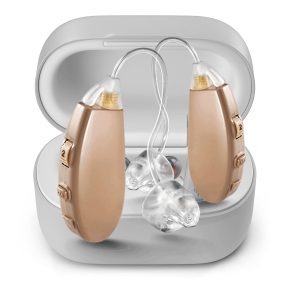
8.6
“Very Good”
★★★★☆
User Ratings (19,725)
$297
PROS
✓ Noise Reduction
✓ Comfortable
✓ Nice Sound Quality
✓ Rechargeable
✓ Fine-Tuning
✓ Easy Setup
CONS
x Bad Out-Of-Box Settings
x Too Big
x Short Battery Life
x Expensive
REVIEW
One of the most prominent advantages of MD Hearing hearing aids is their affordability. They offer a budget-friendly option for individuals seeking hearing assistance without breaking the bank.
MD Hearing hearing aids also stand out for their user-friendly design. They are generally straightforward to operate, catering to a diverse range of users, including those who may not be technologically savvy.
One common concern with MD Hearing hearing aids is that their feature set might be more limited compared to other alternatives. While they may provide satisfactory results for many individuals, those seeking a broader range of advanced features and customization options might find MD Hearing hearing aids lacking in this regard.
Another consideration is the durability and long-term performance of these hearing aids. The build quality and materials used might not be as robust as those found in more expensive models. This could potentially lead to issues over time, impacting the longevity of the device.
FINAL VEREDICT
In conclusion, MD Hearing hearing aids offer a cost-effective solution for individuals seeking accessible hearing assistance. Their user-friendly design and promise of enhanced sound quality make them a competitive choice, especially for those on a tighter budget. However, potential downsides such as limited features and concerns about durability should be weighed against their affordability.
For those seeking a basic and budget-friendly hearing aid option, MD Hearing hearing aids could be a suitable choice, but individuals with more specific needs might want to explore higher-end alternatives.
JABRA
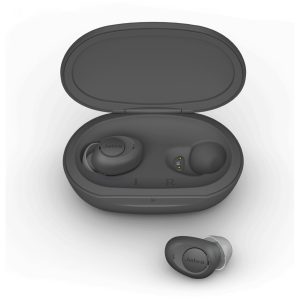
7.3
“Good”
★★★★☆
User Ratings (16,955)
$799
PROS
✓ Small
✓ Easy to Setup
✓ Rechargeable
✓ Adjustable Volume
CONS
x Feedback during Calls
x Tiny Volume Control
x Not the Best Quality
x Outdated
REVIEW
Jabra hearing aids have made a mark in the market with their technological sophistication, seamless connectivity features, and commitment to delivering enhanced auditory experiences. However, as with any product, there are aspects that warrant consideration.
A standout feature of Jabra hearing aids is their integration of advanced technology. These devices incorporate state-of-the-art sound processing algorithms that contribute to a heightened sound quality.
However, it’s important to consider potential drawbacks as well. One notable concern with Jabra hearing aids is their price point. The advanced technology and connectivity features that they offer often come at a higher cost compared to other hearing aid options.
Moreover, the sophisticated technology and connectivity options might not be suitable for everyone. Some users might find these features to be overwhelming or unnecessary for their needs, potentially making the devices more complex than desired. Connectivity issues or compatibility problems could potentially lead to frustration and impact the overall user experience.
FINAL VEREDICT
In conclusion, Jabra hearing aids bring forth a combination of technological advancement, seamless connectivity, and wearer comfort. However, their higher price point, potential complexity, and reliance on wireless connectivity could be considerations for those evaluating their options.
For individuals seeking a hearing aid solution that embraces modern technology and connectivity and are willing to invest, Jabra hearing aids offer a compelling choice. However, those who prioritize simplicity and affordability might need to weigh these advantages against the potential drawbacks.
EARGO
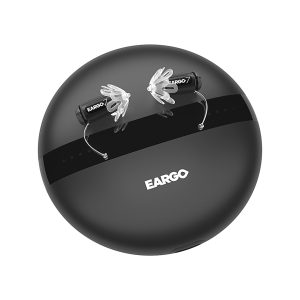
6.8
“Good”
★★★☆☆
User Ratings (11,029)
$1,450
PROS
✓ Comfortable
✓ USB-powered
✓ Rechargeable
✓ Portable
CONS
x Short Battery Life
x Too Big
x Bad Out-Of-Box Settings
x Tiny Volume Control
x Expensive
REVIEW
Eargo hearing aids stand out for their discreet appearance. Designed to fit comfortably within the ear canal, these devices are virtually invisible to others.
Moreover, comfort is a strong suit of Eargo hearing aids. The soft, flexible materials used in their construction ensure that wearers can comfortably wear them for extended periods without discomfort.
However, it’s essential to acknowledge potential drawbacks. One key consideration with Eargo hearing aids is their suitability for individuals with varying degrees of hearing loss. While they are effective for mild to moderate hearing loss, those with more severe hearing impairments might not experience the same level of benefit from these devices.
Another potential concern is the learning curve associated with inserting and removing Eargo hearing aids. The unique design requires wearers to become accustomed to the process, which might pose a challenge for some, especially those with dexterity issues.
Furthermore, Eargo hearing aids might not be the most cost-effective option available. The innovative technology and design features contribute to a higher price point compared to some more traditional hearing aids.
FINAL VEREDICT
In conclusion, Eargo hearing aids offer discreet design, innovative technology, and wearer comfort. However, their suitability for individuals with varying degrees of hearing loss, the learning curve associated with their unique design, and their relatively higher cost are potential considerations.
For those seeking a discreet and comfortable hearing aid option with mild to moderate hearing loss, Eargo hearing aids could provide an effective solution. However, individuals with more severe hearing impairments or those seeking a more budget-friendly choice might want to explore alternative options.
What Is a Hearing Aid?
A hearing aid stands as a diminutive electronic gadget that serves to counterbalance (though not to remedy) mild to severe hearing impairment. An array of styles and dimensions characterize hearing aids, and they can be affixed by individuals of all age groups grappling with hearing deficiency.
How Do Hearing Aids Work?
Conventionally, a hearing aid comprises essential components such as a microphone, amplifier, and speaker. The microphone performs the role of capturing acoustic sound waves, subsequently transmuting them into electrical signals. These signals undergo a sequence of processing and enhancement within the amplifier.
Once refined, the signals proceed to the speaker, where they are once again transformed into audible sound waves. This orchestration results in the delivery of a more intensified and distinct sound experience to the wearer. The application of this sound amplification technique contributes to the enhancement of an individual’s auditory capabilities, rendering speech from others notably more comprehensible and accessible.
Hearing Aid Types
A diverse array of hearing aid types and styles is available, crafted to best accommodate the wearer’s specific requirements: their degree of hearing impairment, preferences for fit, and physical capabilities, such as manual dexterity needed for battery replacement.
Certain hearing aid models are designed to rest externally to the ear, while others snugly occupy the ear canal, and several variants incorporate elements within both the inner and outer ear regions.
The realm of hearing aids encompasses four fundamental types:
- Behind-the-Ear (BTE) Hearing Aids: These devices house all technological components behind the ear, encased in a housing that connects to the inner part of the outer ear via a slender tube, leading to a dome or an ear mold. A prevalent variation is the mini-behind-the-ear (mBTE) or a more streamlined BTE design.
- Receiver-in-Canal (RIC) Hearing Aids: Similar to BTE aids, these are worn behind the ear, yet they employ a contoured wire to link with a petite speaker resting in the ear canal.
- In-the-Ear (ITE) Hearing Aids: These devices are designed to be discreetly situated within the ear canal, devoid of any components extending behind the ear.
- Completely-in-Canal (CIC) Hearing Aids: Custom-crafted to be entirely nestled inside the ear canal, these aids offer a discreet profile.
How Much Do Hearing Aids Cost?
The cost outlay associated with hearing aids can fluctuate substantially contingent on the aid’s manufacturer, the chosen model, supplementary technological attributes, and the audiologist from whom the procurement is made.
By and large, hearing aids are evaluated on an individual basis; thus, in cases of bilateral hearing loss, it’s prudent to multiply the listed prices by two when perusing hearing aid vendor listings. When considering premier manufacturers and models, the introductory price range for a pair of hearing aids during 2023 spanned from approximately $1,400 to upwards of $5,000.
Over-the-Counter (OTC) Hearing Aids
Per the latest regulation, a forthcoming guideline proposes that adults grappling with perceived mild to moderate hearing loss could have access to over-the-counter (OTC) hearing aids.
Envisioned as a more economically feasible alternative compared to existing prescribed choices, these hearing aids are slated to be conveniently obtainable at both brick-and-mortar stores and digital merchants (without an obligatory mandate for the sellers to possess licensing). The procurement of these hearing aids won’t necessitate a medical evaluation, a prescription, or fitting adjustments overseen by an audiologist or hearing healthcare specialist.
Benefits of Using Hearing Aids
- Improved Hearing
The most evident benefit is enhanced hearing capability, allowing you to reconnect with the sounds and conversations you might have been missing.
- Enhanced Communication
Hearing aids facilitate better communication with family, friends, and colleagues, enabling you to actively participate in conversations and social interactions.
- Increased Safety
Improved hearing contributes to better awareness of your surroundings, including potential hazards like alarms, sirens, and approaching vehicles.
- Enhanced Quality of Life
Hearing aids can lead to increased confidence, reduced feelings of isolation, and a better overall quality of life by allowing you to engage more fully in various activities.
- Preservation of Cognitive Abilities
Treating hearing loss with hearing aids has been associated with a potential reduction in the risk of cognitive decline and conditions like dementia.
- Professional Advantages
In professional settings, hearing aids can improve your performance by helping you stay engaged in meetings, discussions, and important conversations.
Factors to Avoid when Choosing Hearing Aids:
- Not Considering Lifestyle Needs
Failing to consider your daily activities and communication needs can result in choosing a hearing aid that doesn’t suit your lifestyle.
- Neglecting Comfort and Fit
Ignoring the comfort and fit of the hearing aid can lead to discomfort and reduced wearability.
- Disregarding User Reviews
Not paying attention to user reviews and experiences can prevent you from making an informed decision about the hearing aid’s performance and reliability.
- Overlooking Battery Life
Neglecting to consider the battery life of the hearing aid can result in frequent disruptions and the hassle of changing batteries.
- Choosing Based on Brand Alone
Relying solely on brand reputation without evaluating specific features and suitability for your needs can result in an ill-fitting choice.

Olivia Mitchell – Health Tech Journalist and Reviewer
Olvivia has been a recognized presence in the field of auditory technology for over seven years. Their publications have cultivated a devoted community of hearing device enthusiasts who rely on their expertise for the latest insights and evaluations. Alex is an enthusiastic supporter of accessible audio experiences and enjoys experimenting with custom configurations of hearing devices.
